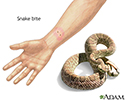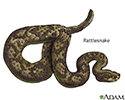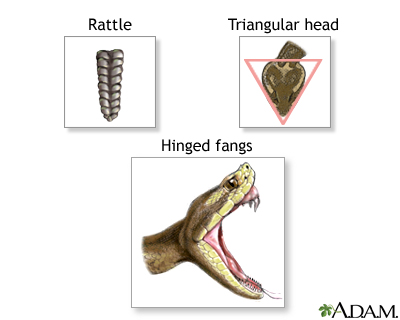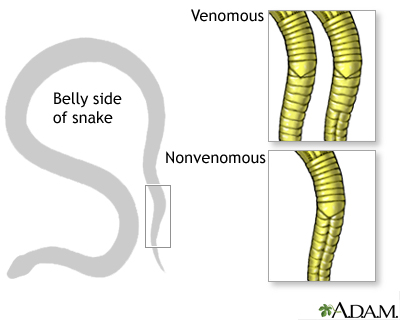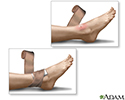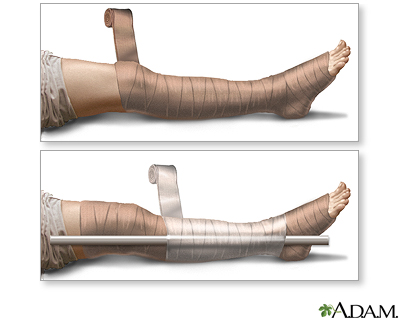Snake bites
Bites - snakes
Snake bites occur when a snake bites the skin. They are medical emergencies if the snake is venomous.
Venomous animals account for a large number of deaths and injuries worldwide. Snakes alone are estimated to inflict 2.5 million venomous bites each year, resulting in about 125,000 deaths. The actual number may be much larger. Southeast Asia, India, Brazil, and areas of Africa have the most deaths due to snakebite.
Considerations
Snake bites can be deadly if not treated quickly. Because of their smaller body size, children are at higher risk for death or serious complications due to snake bites.
The right antivenom can save a person's life. Getting to an emergency room as quickly as possible is very important. If properly treated, many snake bites will not have serious effects.
Causes
Most species of snake are harmless and their bites are not life threatening.
Venomous snake bites include bites by any of the following:
- Cobra
- Copperhead
- Coral snake
- Cottonmouth (water moccasin)
- Rattlesnake
- Various snakes found at zoos
Most snakes will avoid people if possible, but all snakes will bite as a last resort when threatened or surprised. If you are bitten by any snake, treat it seriously.
Symptoms
Symptoms depend on the type of snake, but may include:
- Bleeding from wound
-
Blurred vision
Blurred vision
There are many types of eye problems and vision disturbances, such as: HalosBlurred vision (the loss of sharpness of vision and the inability to see ...
 ImageRead Article Now Book Mark Article
ImageRead Article Now Book Mark Article - Burning of the skin
-
Convulsions
Convulsions
A seizure is the physical findings or changes in behavior that occur after an episode of abnormal electrical activity in the brain. The term "seizure...
 ImageRead Article Now Book Mark Article
ImageRead Article Now Book Mark Article - Diarrhea
-
Dizziness
Dizziness
Dizziness is a term that is often used to describe 2 different symptoms: lightheadedness and vertigo. Lightheadedness is a feeling that you might fai...
 ImageRead Article Now Book Mark Article
ImageRead Article Now Book Mark Article -
Excessive sweating
Excessive sweating
Sweating is the release of liquid from the body's sweat glands. This liquid contains salt. This process is also called perspiration. Sweating helps...
 ImageRead Article Now Book Mark Article
ImageRead Article Now Book Mark Article -
Fainting
Fainting
Fainting is a brief loss of consciousness due to a drop in blood flow to the brain. The episode most often lasts less than a couple of minutes and y...
Read Article Now Book Mark Article - Fang marks in the skin
-
Fever
Fever
Fever is the temporary increase in the body's temperature in response to a disease or illness. A child has a fever when the temperature is at or abov...
 ImageRead Article Now Book Mark Article
ImageRead Article Now Book Mark Article -
Increased thirst
Increased thirst
Excessive thirst is an abnormal feeling of always needing to drink fluids.
 ImageRead Article Now Book Mark Article
ImageRead Article Now Book Mark Article -
Loss of muscle coordination
Loss of muscle coordination
Uncoordinated movement is due to a muscle control problem that causes an inability to coordinate movements. It leads to a jerky, unsteady, to-and-fr...
 ImageRead Article Now Book Mark Article
ImageRead Article Now Book Mark Article -
Nausea and vomiting
Nausea and vomiting
Nausea is feeling an urge to vomit. It is often called "being sick to your stomach. "Vomiting or throwing-up is forcing the contents of the stomach ...
 ImageRead Article Now Book Mark Article
ImageRead Article Now Book Mark Article -
Numbness and tingling
Numbness and tingling
Numbness and tingling are abnormal sensations that can occur anywhere in your body, but they are often felt in your fingers, hands, feet, arms, or le...
 ImageRead Article Now Book Mark Article
ImageRead Article Now Book Mark Article -
Rapid pulse
Rapid pulse
A bounding pulse is a strong throbbing felt over one of the arteries in the body. It is due to a forceful heartbeat.
 ImageRead Article Now Book Mark Article
ImageRead Article Now Book Mark Article - Tissue death
- Severe pain
- Skin discoloration
-
Swelling
at the site of the bite
Swelling
Swelling is the enlargement of organs, skin, or other body parts. It is caused by a buildup of fluid in the tissues. The extra fluid can lead to a ...
 ImageRead Article Now Book Mark Article
ImageRead Article Now Book Mark Article - Weakness
Rattlesnake bites are painful when they occur. Symptoms usually begin right away and may include:
- Bleeding
- Breathing difficulty
-
Blurred vision
Blurred vision
There are many types of eye problems and vision disturbances, such as: HalosBlurred vision (the loss of sharpness of vision and the inability to see ...
 ImageRead Article Now Book Mark Article
ImageRead Article Now Book Mark Article -
Eyelid drooping
Eyelid drooping
Ptosis (eyelid drooping) in infants and children is when the upper eyelid is lower than it should be. This may occur in one or both eyes. Eyelid dr...
 ImageRead Article Now Book Mark Article
ImageRead Article Now Book Mark Article -
Low blood pressure
Low blood pressure
Low blood pressure occurs when blood pressure is much lower than normal. This means the heart, brain, and other parts of the body do not get enough ...
Read Article Now Book Mark Article - Nausea and vomiting
-
Numbness
Numbness
Numbness and tingling are abnormal sensations that can occur anywhere in your body, but they are often felt in your fingers, hands, feet, arms, or le...
 ImageRead Article Now Book Mark Article
ImageRead Article Now Book Mark Article - Pain at site of bite
- Paralysis
- Rapid pulse
-
Skin color changes
Skin color changes
Rashes involve changes in the color, feeling or texture of your skin.
 ImageRead Article Now Book Mark Article
ImageRead Article Now Book Mark Article - Swelling
- Tingling
- Tissue damage
- Thirst
- Tiredness
- Weakness
- Weak pulse
Cottonmouth and copperhead bites are painful right when they occur. Symptoms, which usually begin right away, may include:
- Bleeding
- Breathing difficulty
- Low blood pressure
- Nausea and vomiting
- Numbness and tingling
- Pain at site of bite
- Shock
- Skin color changes
- Swelling
- Thirst
- Tiredness
- Tissue damage
- Weakness
- Weak pulse
Coral snake bites may be painless at first. Major symptoms may not develop for hours. Do NOT make the mistake of thinking you will be fine if the bite area looks good and you are not in a lot of pain. Untreated coral snake bites can be deadly. Symptoms may include:
- Blurred vision
- Breathing difficulty
-
Convulsions
Convulsions
A seizure is the physical findings or changes in behavior that occur after an episode of abnormal electrical activity in the brain. The term "seizure...
 ImageRead Article Now Book Mark Article
ImageRead Article Now Book Mark Article - Drowsiness
- Eyelid drooping
- Headache
- Low blood pressure
-
Mouth watering (
excessive salivation
)
Excessive salivation
Drooling is saliva flowing outside the mouth.
 ImageRead Article Now Book Mark Article
ImageRead Article Now Book Mark Article - Nausea and vomiting
- Numbness
- Pain and swelling at site of bite
- Paralysis
- Shock
- Slurred speech
- Swallowing difficulty
- Swelling of tongue and throat
- Weakness
- Skin color changes
- Skin tissue damage
- Stomach or abdominal pain
- Weak pulse
First Aid
Follow these steps to provide first aid:
1. Keep the person calm. Reassure them that bites can be effectively treated in an emergency room. Restrict movement, and keep the affected area below heart level to reduce the flow of venom.
2. Remove any rings or constricting items, because the affected area may swell. Create a loose splint to help restrict movement of the area.
3. If the area of the bite begins to swell and change color, the snake was probably venomous.
4. Monitor the person's vital signs -- temperature, pulse , rate of breathing, and blood pressure -- if possible. If there are signs of shock (such as paleness ), lay the person flat, raise the feet about a foot (30 centimeters), and cover the person with a blanket.
Vital signs
Vital signs reflect essential body functions, including your heartbeat, breathing rate, temperature, and blood pressure. Your health care provider m...

Shock
Shock is a life-threatening condition that occurs when the body is not getting enough blood flow. Lack of blood flow means that the cells and organs...

Paleness
Paleness is an abnormal loss of color from normal skin or mucous membranes.

5. Get medical help right away.
6. Bring in the dead snake only if this can be done safely. Do not waste time hunting for the snake, and do not risk another bite if it is not easy to kill the snake. Be careful of the head when transporting it -- a snake can actually bite (from a reflex) for several hours after it's dead.
Do Not
Follow these precautions:
- Do NOT allow the person to become over-exerted. If necessary, carry the person to safety.
- Do NOT apply a tourniquet.
- Do NOT apply cold compresses to a snake bite.
- Do NOT cut into a snake bite with a knife or razor.
- Do NOT try to suck out the venom by mouth.
-
Do NOT give the person
stimulants
or
pain medicines
unless a doctor tells you to do so.
Stimulants
Stimulants are drugs that increase your heart rate, breathing rate, and brain function. Some stimulants affect only a specific organ, such as the he...
 ImageRead Article Now Book Mark Article
ImageRead Article Now Book Mark ArticlePain medicines
Over-the-counter (OTC) pain relievers can help relieve pain or lower a fever. Over-the-counter means you can buy these medicines without a prescript...
 ImageRead Article Now Book Mark Article
ImageRead Article Now Book Mark Article - Do NOT give the person anything by mouth.
- Do NOT raise the site of the bite above the level of the person's heart.
When to Contact a Medical Professional
Call 911 or your local emergency number if someone has been bitten by a snake. If possible, call ahead to the emergency room so that antivenom can be ready when the person arrives.
Your local poison center can be reached directly by calling the national toll-free Poison Help hotline (1-800-222-1222) from anywhere in the United States. This national hotline number will let you talk to experts. They will give you further instructions.
Poison Help hotline
For a POISON EMERGENCY call:1-800-222-1222ANYWHERE IN THE UNITED STATESThis national hotline number will let you talk to experts in poisoning. This ...

This is a free and confidential service. All local poison control centers in the United States use this national number. You should call if you have any questions about poisoning or poison prevention. It does NOT need to be an emergency. You can call for any reason, 24 hours a day, 7 days a week.
Prevention
To prevent snake bites:
- Avoid areas where snakes may be hiding, such as under rocks and logs.
- Even though most snakes are not venomous, avoid picking up or playing with any snake unless you have been properly trained.
- Don't provoke a snake. That is when many serious snake bites occur.
- Tap ahead of you with a walking stick before entering an area where you can't see your feet. Snakes will try to avoid you if given enough warning.
- When hiking in an area known to have snakes, wear long pants and boots if possible.
References
Norris RL. Venomous snakebites in North America. In: Adams JG, ed. Emergency Medicine. 2nd ed. Philadelphia, PA: Elsevier Saunders; 2013:chap 139.
Otten EJ. Venomous animal injuries. In: Marx JA, Hockberger RS, Walls RM, et al, eds. Rosen's Emergency Medicine: Concepts and Clinical Practice . 8th ed. Philadelphia, PA: Elsevier Saunders; 2014:chap 62.
-
Snake bite on the finger - illustration
A bite from a venomous snake can cause tissue death (necrosis) swelling, bleeding and destruction of blood cells (hematological problems), and nerve (neurological) damage (coma, paralysis). This snake bite has caused swelling and local tissue death on the finger.
Snake bite on the finger
illustration
-
Snake bite on the finger - illustration
A bite by a venomous snake can cause local tissue death (necrosis), bleeding and destruction of blood cells (hematological problems), and nerve (neurological) damage (coma, paralysis). This snake bite has caused the hand to swell and local tissue death on the finger.
Snake bite on the finger
illustration
-
Snake bite - illustration
Venomous snake bites are medical emergencies and require immediate attention. The bite of a snake can cause severe local tissue damage and often requires follow-up care. The right anti-venom can save a person's life. Even though most snakes are not poisonous, avoid picking up or playing with any snake unless you have been properly trained.
Snake bite
illustration
-
Venomous snakes - Series
Presentation
-
Snakebite (venomous) - Series
Presentation
-
Snake bite on the finger - illustration
A bite from a venomous snake can cause tissue death (necrosis) swelling, bleeding and destruction of blood cells (hematological problems), and nerve (neurological) damage (coma, paralysis). This snake bite has caused swelling and local tissue death on the finger.
Snake bite on the finger
illustration
-
Snake bite on the finger - illustration
A bite by a venomous snake can cause local tissue death (necrosis), bleeding and destruction of blood cells (hematological problems), and nerve (neurological) damage (coma, paralysis). This snake bite has caused the hand to swell and local tissue death on the finger.
Snake bite on the finger
illustration
-
Snake bite - illustration
Venomous snake bites are medical emergencies and require immediate attention. The bite of a snake can cause severe local tissue damage and often requires follow-up care. The right anti-venom can save a person's life. Even though most snakes are not poisonous, avoid picking up or playing with any snake unless you have been properly trained.
Snake bite
illustration
-
Venomous snakes - Series
Presentation
-
Snakebite (venomous) - Series
Presentation
Review Date: 11/4/2015
Reviewed By: Jesse Borke, MD, FACEP, FAAEM, Attending Physician at FDR Medical Services/Millard Fillmore Suburban Hospital, Buffalo, NY. Also reviewed by David Zieve, MD, MHA, Isla Ogilvie, PhD, and the A.D.A.M. Editorial team.




